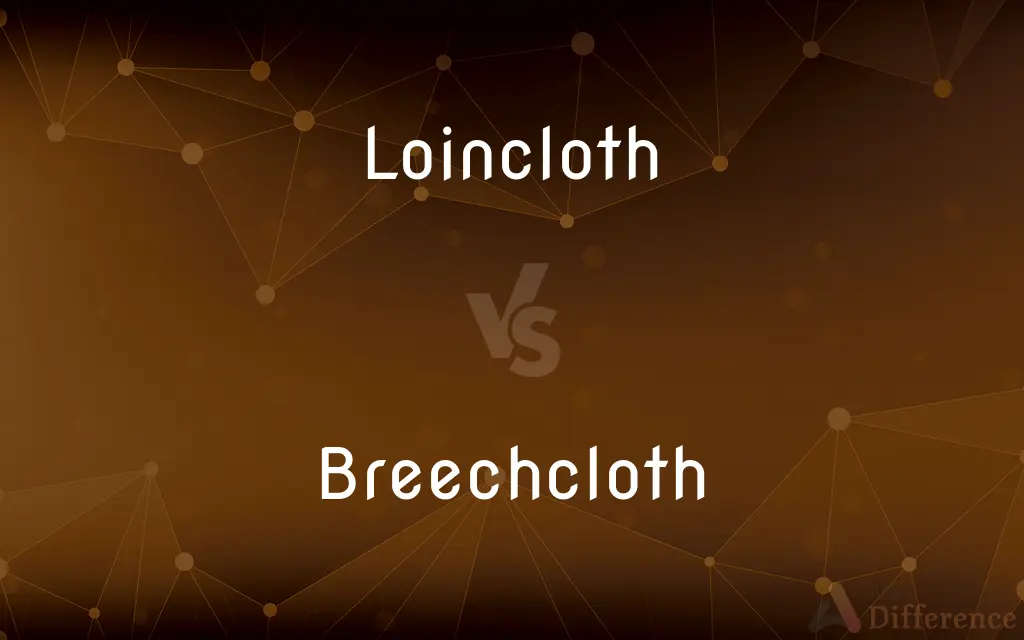Loincloth vs. Breechcloth — What's the Difference?
By Tayyaba Rehman & Urooj Arif — Updated on April 1, 2024
Loincloth is simple garment designed to cover genitals and sometimes buttocks, worn by men in various cultures. Breechcloth is type of loincloth that covers only the genitals, consisting of a strip of fabric passed between the thighs and secured by belt.

Difference Between Loincloth and Breechcloth
Table of Contents
ADVERTISEMENT
Key Differences
A loincloth serves as one of the most basic forms of clothing, primarily designed to cover the wearer's genitals. Historically, it has been worn in many different cultures around the world as a primary garment. Its design and material may vary, but its primary function is to provide minimal coverage and support. On the other hand, a breechcloth is a specific type of loincloth that is characterized by a strip of material that goes between the thighs and covers the genitals. The breechcloth is often secured by a belt or other garment wrapped around the waist, ensuring that it stays in place.
While loincloths can be designed to wrap around the waist and cover the buttocks and genitals, providing a form of minimal shorts, breechcloths are specifically focused on covering only the genital area, with less emphasis on covering the buttocks comprehensively. This distinction highlights the breechcloth's role in providing necessary coverage while maximizing mobility and minimizing material use.
The wearing of a loincloth can be traced back to various ancient civilizations, including those in Egypt, Mesopotamia, and the Indus Valley, where it was adapted to local customs and climates. Breechcloths, similarly, have been prominently used by indigenous peoples of the Americas. Both garments reflect adaptations to environmental conditions, social norms, and practical needs of the wearer.
In terms of construction, loincloths may be made from a single piece of cloth that wraps around the waist and between the legs, sometimes extending into longer panels at the front and back. Breechcloths, however, are typically simpler, requiring less material, and are focused solely on frontal genital coverage, with the material secured by a belt or cord at the waist.
Despite their differences, both garments serve a similar basic purpose of covering and protection. They are both symbols of simplicity and functionality in clothing design, reflecting the cultural practices and environmental adaptations of their wearers. Today, while not common in everyday wear in most cultures, they remain significant in cultural ceremonies, historical reenactments, and discussions on the evolution of clothing.
ADVERTISEMENT
Comparison Chart
Coverage
Covers genitals and sometimes buttocks
Specifically covers only the genitals
Design
May wrap around the waist and between the legs
A strip of fabric passed between the thighs
Use
Worn in many cultures as a primary garment
Used primarily by indigenous peoples of the Americas
Material
Can be made from various materials
Typically requires less material than a loincloth
Purpose
Provides minimal coverage and support
Focuses on necessary coverage while maximizing mobility
Compare with Definitions
Loincloth
Can be elaborate or simple.
The ceremonial loincloth was decorated with intricate beadwork.
Breechcloth
A strip of fabric for covering the genitals.
The warrior adjusted his breechcloth before the dance.
Loincloth
A simple garment for covering the lower body.
He wore a traditional loincloth as part of his historical costume.
Breechcloth
Secured by a belt around the waist.
His breechcloth was held in place by a leather belt.
Loincloth
Symbolizes simplicity in design.
The loincloth represents the most basic form of clothing.
Breechcloth
Focuses on frontal coverage.
The breechcloth provides sufficient frontal coverage for the ceremony.
Loincloth
Versatile in its cultural usage.
Loincloths vary in style from culture to culture.
Breechcloth
Requires minimal material.
A small piece of fabric is enough to make a breechcloth.
Loincloth
Often made from cloth or animal skins.
The hunter's loincloth was made from the hide of his first catch.
Breechcloth
Maximizes mobility for the wearer.
The breechcloth allowed him to move freely during the hunt.
Loincloth
A loincloth is a one-piece garment, either wrapped around itself or kept in place by a belt. It covers the genitals and, at least partially, the buttocks.
Breechcloth
A cloth worn to cover the loins; a loincloth.
Loincloth
A strip of cloth worn around the loins.
Breechcloth
An apron-like garment held on by a belt tied around the waist to cover the loins; a loincloth.
Loincloth
A garment worn about the loins and covering the crotch.
Breechcloth
A cloth worn around the breech.
Loincloth
A cloth covering for the loins, worn around the hips; - sometimes worn in tropical areas as the only article of clothing.
Breechcloth
A garment that provides covering for the loins
Loincloth
A garment that provides covering for the loins
Common Curiosities
Were loincloths worn by women?
Primarily, loincloths have been worn by men in various cultures, though similar garments might be used by women for specific purposes or within certain cultural contexts.
What distinguishes a breechcloth from a loincloth?
A breechcloth is a type of loincloth that specifically covers only the genitals, usually consisting of a strip of fabric secured by a belt, focusing on frontal coverage.
How is a breechcloth worn?
A breechcloth is worn by passing a strip of fabric between the thighs and securing it with a belt around the waist.
Can a breechcloth provide sufficient protection and coverage?
Yes, breechcloths are designed to provide necessary coverage for the genitals while maximizing mobility, especially in warm climates or during specific activities.
What materials are used to make loincloths and breechcloths?
They can be made from a variety of materials, including cloth and animal skins, depending on the cultural and environmental context.
What is a loincloth?
A loincloth is a basic garment designed to cover the lower body, primarily the genitals, and sometimes the buttocks.
How have loincloths influenced modern clothing?
Loincloths have influenced the design of modern underwear and swimwear, providing a foundation for the development of these garments.
Is there a ceremonial significance to loincloths or breechcloths?
In many cultures, these garments have ceremonial or symbolic significance, often worn during rituals, dances, or cultural ceremonies.
Are loincloths still used today?
While not common in daily wear in most cultures, loincloths may still be used in certain cultural ceremonies, rituals, or historical reenactments.
How do loincloths and breechcloths reflect cultural adaptation?
They reflect adaptation to environmental conditions, available materials, and social norms, showcasing the ingenuity and practicality of traditional clothing designs.
Share Your Discovery

Previous Comparison
Collin vs. Colin
Next Comparison
Saxophone vs. TubaAuthor Spotlight
Written by
Tayyaba RehmanTayyaba Rehman is a distinguished writer, currently serving as a primary contributor to askdifference.com. As a researcher in semantics and etymology, Tayyaba's passion for the complexity of languages and their distinctions has found a perfect home on the platform. Tayyaba delves into the intricacies of language, distinguishing between commonly confused words and phrases, thereby providing clarity for readers worldwide.
Co-written by
Urooj ArifUrooj is a skilled content writer at Ask Difference, known for her exceptional ability to simplify complex topics into engaging and informative content. With a passion for research and a flair for clear, concise writing, she consistently delivers articles that resonate with our diverse audience.














































